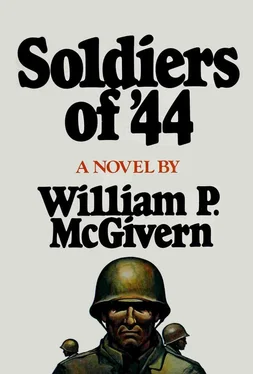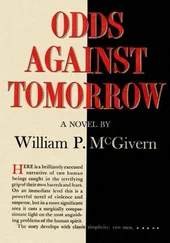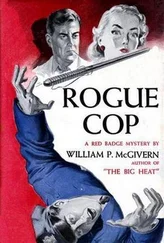The jeep itself swung about in a wild lashing circle, then went over the side of the road, taking the bodies of the lieutenant and his driver into the depths of a gorge studded with jagged rocks and the stumps of spruce and pine trees...
A half mile away, Waffen SS Captain Walter Brecht stood beside his recon car and studied the road below him through U.S. Army binoculars, watching smoke and flames curling up from the wreckage of the American jeep, spreading through the trees and underbrush, creating dull yellow reflections against the cover of haze and mists, and the sight reminded him of Guernica, and standing braced against the wind on foreign soil once again, Brecht thought suddenly and resentfully of Karl Jaeger, knowing that it was not possible to apply Jaeger’s fine distinctions on how one killed his country’s enemies. The soldiers in the burning jeep below him were as dead as if he had eliminated them in a punctilious duel, or as if they had fought each other to the death with lances on the backs of chargers. It was an indulgence close to outright treason to prefer to destroy your enemy by honorable means — the word stood out in his mind in brackets — in “honorable” cavalry charges or behind an “honorable” flash of bayonets. This wasn’t a chivalric war; the very phrase was an absurdity.
Jaeger’s division. Das Reich, was on schedule, Brecht knew, spearheading elements of General Dietrich’s Sixth SS Army across the Salm Valley. His tanks were smashing through all resistance, “honorably” destroying bridges and villages and farms, spreading “honorable” terror over hundreds of square miles in the Ardennes, and these bloody pursuits were considered “honorable” simply because Jaeger and his men wore field-gray uniforms with silver SS runes on their tunics. With their Knight’s, Crosses and polished boots they had convenient memories. No one boasted of Das Reich at Oradour-sur-Glane, with the locked church jammed with women and children and put to the torch... No, that name would never be celebrated in drinking songs or emblazoned on Das Reich’s battle standards.
Brecht was proud to be known as “Der Henker” and needed no excuse for his role in Operation Christrose. Whenever you killed your country’s enemies was the right time for it. However you did it was a good way to do it. It didn’t matter that it might earn one only a crude tarpaulin, the wooden arrow pointing to the sky above a grave, to the mournful strains of “Ich halt’ einen Kameraden.”
Brecht recalled then — memory was a strange and illusive comrade itself, he decided — the name of the song on the opposite side of the Bing Crosby recording of “White Christmas.” It had been an awkward moment when he’d forgotten, but the Americans had been too careless to notice. “Stille Nacht,” yes, “Silent Night,” and it seemed an appropriate and fortuitous thought with Christmas and the memories of silver bells so close at hand.
December 20, 1944. Le Pont, Belgium. Wednesday, 0600 Hours.
Section Eight had been dug in for three days on the crest of Mont Reynard. From that height they had a view of the Salm valley and the village far below them on the curve of the river. Opposite their gun positions, a thousand yards away, were the gatehouse of the Bonnards and the dark castle (which they had learned was called Castle, or Château, Rêve).
The top of Mont Reynard was the size of a football field, an expanse of slate and rock broken only by sparse clusters of spruce and oak and rime-whitened growths of bracken and wild berry bushes.
The men worked two days and nights using dynamite and shovels to blast and shape protective revetments for their weapons and ammunition. The M-51 machine-gun mount (with quadruple fifties) was emplaced at the fork of the narrow road that led up to the gatehouse. On the other side of the hill, rising above the Salm Valley, the cannon was secure in a deep enclosure of frozen rocks. Under the frost line they had found a gritty soil, laced with splintered shale, and with it had filled dozens of sandbags to line the top of the low barricades.
In smaller revetments behind the cannon were the section’s power motor and fire-control apparatus, a metal-encased unit supported by a tripod and fitted with a range wheel and telescopic sights. These fed electronic data directly to the cannon and automatically controlled its tracking patterns. When linked to the director, the cannon could fire one hundred and twenty rounds per minute, each point-detonating projectile containing sixteen ounces of trinitrocellulose. The synchronized machine guns were capable of firing bursts of three thousand rounds per minute and these weapons, plus rifles, carbines, bazookas and grenades, gave the section lethal firepower.
Near the cannon revetment, the men had widened an opening in an escarpment of rock, clearing away loose shale and underbrush, and covering the narrow entrance with a tarp to make a shelter from snow and winds. When the position was secure, with frozen tree limbs and bushes camouflaging the circular outlines of the revetments. Docker split the section into two units, assigning one to the guns and sending Larkin and four of the younger soldiers across the hill to the Bonnards’ to get some sleep. He then walked to the edge of the precipice and studied the valley through his binoculars. Only the faintest dawn light touched the village and the spires of the squat little church. Nothing was moving except a fox or a dog digging among the weeds at the river’s edge.
As long as they could hold the hill, Docker planned to relieve the men in shifts, giving each a chance to scrub and change into dry clothes, the only way to prevent rashes and the crippling effect of trench foot in this wet, freezing weather. There was plenty of windfallen firewood on the hill and food for at least ten days — canned turkey, salt pork, powdered milk and eggs, flour and K-rations. In the trench they’d dug for ammo were two hundred and eight 40-millimeter projectiles and several thousand rounds of .50-caliber shells. Secure in a smaller revetment, topped by fresh-cut logs, were two insulated boxes of dynamite, firing plungers, detonating caps and loops of fusing wire obtained by Trankic from a British sappers’ unit on their hot and dusty march to Avranches; with Docker’s permission, the corporal had traded-off five gallons of black whiskey for these extra explosives and hardware.
Docker had known for the last two days that his section was cut off behind the German lines, isolated on this mountain under a low bowl of sky. As the light spread, the wind died. In this vacuum, the cold and silence were intensified to a harrowing pitch; every sound trembled on the frozen winds, the scurrying of small animals in the trees, the distant rumble of artillery on the horizons.
Trankic walked across the hill from the jeep and joined Docker. “I just picked up something kind of funny.” The big corporal’s cheeks were so swollen with the winds and sleet that his eyes looked like pinpoints of light under his helmet. Docker knew he hadn’t slept more than a few hours since they’d brought the trucks up the twisting road to Mont Reynard. “It was a transmitter in a town called La Roach-something-or-other, but the guy sending was an American. Claimed he was in a truck that got blown up on a bridge there with a lot of other GIs. He says the guys who blew the bridge were American soldiers. And he wasn’t off the air more than a minute before I got another signal, this time from our own network in Brussels saying there’re all sorts of Germans behind the lines in our uniforms. So you know what I’m thinking.”
Docker nodded. “Frigging A.”
“He certainly looks like an all-American kid.”
Читать дальше

![Уильям Макгиверн - Завтра опять неизвестность [английский и русский параллельные тексты]](/books/35168/uilyam-makgivern-zavtra-opyat-neizvestnost-angli-thumb.webp)









